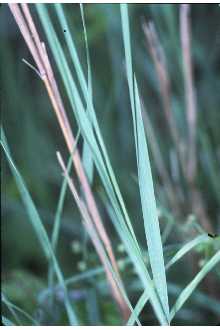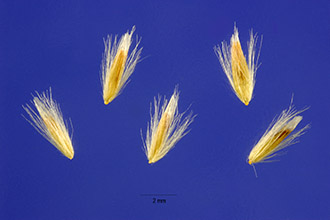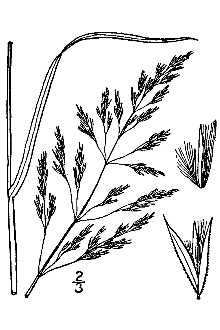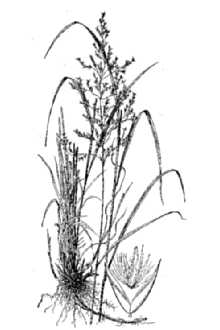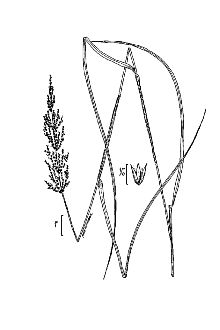Bluejoint
Scientific Name: Calamagrostis canadensis (Michx.) P. Beauv.
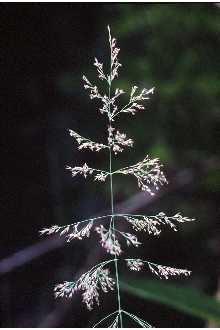
| General Information | |
|---|---|
| Usda Symbol | CACA4 |
| Group | Monocot |
| Life Cycle | Perennial |
| Growth Habits | Graminoid |
| Native Locations | CACA4 |
Plant Guide
Alternate Names
Bluejoint or Macoun’s Reedgrass
Uses
Calamogrostis canadensis is a wetland species that has forage value for deer, bison, and cattle (Hogg and Lieffers, 1991). It produces good quality hay when harvested prior to heading. Forage quality is highest about three weeks before boot stage (McKendrick et al., 1977). It also has value as a food for waterfowl.
Status
Please consult the PLANTS Web site and your State Department of Natural Resources for this plant’s current status (e.g. threatened or endangered species, state noxious status, and wetland indicator values).
Weediness
This plant may become weedy or invasive in some regions or habitats and may displace desirable vegetation if not properly managed. Please consult with your local NRCS Field Office, Cooperative Extension Service office, or state natural resource or agriculture department regarding its status and use. Weed information is also available from the PLANTS Web site at plants.usda.gov. Robert H. Mohlenbrock USDA SCS 1989. Midwest Wetland Flora
Description
General: Grass Family (Poaceae). Bluejoint is a tall, erect, cool season perennial grass that is found in wet meadows and prairies. The creeping rhizomes and rootstocks of this species result in natural stands having a hummocky, uneven appearance. The erect stems are slender and not branched and can be 1 to 2 meters tall. The leaves are elongated and very narrow, with a bluish green color and are rough to the touch. The caryopses are ellipsoidal, yellow-brown, smooth, and about 1 to 1.5 mm long. The inflorescence is an open panicle with a caryopsis borne singly in each spikelet (Barkley, 1986). Flowers June to August and is a typical wind pollinated species like most of the grasses. Calamagrostis canadensis possesses the C-3 photosynthetic pathway for carbon fixation (Waller and Lewis, 1979). Distribution: For current distribution, please consult the Plant Profile page for this species on the PLANTS Web site. It has a distribution from Greenland to Alaska south to North Carolina, Kansas, and California. Habitat: Bluejoint survives best in moist to saturated soils, but not soils inundated by water. The species has an extremely broad distribution and a wide ecological amplitude occurring in diverse wetland areas.
Adaptation
According to Mitchell (1974) mature bluejoint stands tolerate thick build up of litter and mulch. This species occurs in highly organic peat and clay soils, but prefers a silt type soil (Hammer, 1992). This species is adapted to a variety of temperature (-40 to 105 degrees F) and precipitation regimes. It stands up well to winter conditions and is extremely winter hardy (Eggers and Reed, 1987). The species demonstrates broad ecological amplitudes occurring in lowland wetlands to windswept alpine ridges (Mitchell, 1968). It has a wide pH tolerance (pH 5 to 8) from acidic soils to more alkaline water (LaBaugh, 1989). It can tolerate fresh water to slightly brackish ( 0 to 10 ppt) (Hammer, 1992). Eggers and Reed (1987) noted that the species is usually a subdominant in sedge (Carex) meadows, and occurs in open woods, especially after fire and logging. Other grasses associated with Calamagrostis include Spartina pectinata, Beckmannia syzigachne, Scolochloa festucacea, and Poa palustris (Fulton et al., 1986).
Management
Because unfertilized bluejoint is intolerant of heavy grazing or repeated harvests, harvesting should be restricted to a single event per year. To maintain adequate stands of bluejoint, harvest should be performed before flowering and only on alternate years (McKendrick et al. 1977). McKendrick et al. (1977) noted that fertilized stands (1-2 tons dry matter / acre) of bluejoint produced three times more forage than did unfertilized stands (0.5 tons dry matter / acre). Mitchell (1974) found that fertilized stands produced crude leaf protein of 12-20% dry weight during mid-June harvests. Unfertilized forage was found to have marginal calcium and magnesium content and its digestibility was reduced (Corns and Schraa, 1962). Sparrow and Panciera (2005) found that clipping can improve late season forage quality. Bluejoint seeds are much smaller than those of most other forage grasses and require specialized processing after harvest (Klebesadel et al. 1962). Their small size results in generally poor seedling vigor, thus requiring very shallow seeding and effective weed control during establishment.
Pests and Potential Problems
Norton et al. (1987) reported that the nematode Subanguina calamagrostis invades the leaf tissue of the grass and forms galls that cause the leaves to become twisted and contorted. A fungus Dilophospora alopecuri (Fr.) Fr. also invades leaves of the grass due to the entry wound caused by the nematode (Norton et al., 1987). Mitchell (1979b) also reported that an insect invades the sheath of the flag leaf and severs the culm at the base of the inflorescence, thus interfering with seed production. Heavy grazing and trampling by cattle breaks grass rhizomes and adds to soil compaction in wet meadows. Fulton et al.(1986) noted that heavy grazing reduces stands of bluejoint which allows invasion by other wetland grasses, sedges, reeds, rushes, and smartweeds. The invasion of manna grass (Glyceria grandis) is the best indicator of grazing disturbance in the prairie pothole region (Fulton et al., 1986).
Seeds and Plant Production
Plant Production , Use soil moisture sensors to measure the soil moisture of Bluejoint.
Plant Production
Seed is more commonly used for revegetation projects than vegetative materials. Seed production is highly variable among ecotypes and low production results in higher seed costs. Seed yields of 20 to 50 pounds per acre can be expected if grown on agricultural stations or commercial growers (Mitchell, 1979a). Panicles can be collected by hand in wetter sites and combined on drier sites. Panicles should be harvested before seed shatter for maximum seed production. Mitchell (1979a) indicated that bluejoint contained from 3.5 to 4.0 million seeds per pound. Obtaining clean seed units of Calamagrostis are difficult due to the tufts of hairs attached to the lemma bracts. Panicles are threshed with a hammer mill to remove lemmas and hair tufts from lemmas (Klebesadel, et al. 1962). Klebesadel (1962) noted that seed fed into a hammer mill operating at 1200 rpm’s with a 0.5 inch screen diameter round hole will dislodge 60 % of the caryopses from the lemmas and remove 25 to 30 per cent of the hairs from the lemmas. Seeds of bluejoint do not appear to have any complicated germination requirements. Germination, seed viability and dormancy were studied by Conn in 1990. This researcher noted that Calamagrostis seed remained viable (greater than 84%) for at least two years after collection and storage. Klebesadel et al. (1962) noted that this species had no dormancy or after ripening requirements and germination was not improved by scarification, stratification or light treatments. Chromosome number is variable with 2n=28 to 66. Several chromosomal races exist, the major ones being C. canadensis var. canadensis and var. macrouniana 2n=42 (Greene, 1984) in the continental U.S. and C. canadensis var. langsdorfii 2n=56 (Mitchell, 1968) which occurs primarily in Alaska. Within Calamagrostis polyploid complexes exist as well as interspecific hybridization involving apomictic (seed from unfertilized eggs) forms are suspected. Hybrids produce fruits by sexual and apomictic means (Greene, 1984). Cultivars, Improved, and Selected Materials (and area of origin) ‘Sourdough’ bluejoint reedgrass is a cultivar developed by the Alaska Experiment Station for revegetation uses. Collections (36) from the interior, western and south central Alaska were combined into a synthetic population to produce ‘Sourdough’. The cultivar ‘Sourdough’ tolerates severe cold and wind under arctic and alpine conditions, and resists snow mold infestations (Mitchell, 1980). Breeder and foundation class seeds are maintained by the Alaska Plant Materials Center. Registered and certified class seeds are available through the Alaska Seed Growers, Inc. Contact your local Natural Resources
Conservation
Service (formerly Soil Conservation Service) office for more information. Look in the phone book under ”United States Government”. The Natural Resources Conservation Service will be listed under the subheading “Department of Agriculture.”
Control
Please contact your local agricultural extension specialist or county weed specialist to learn what works best in your area and how to use it safely. Always read label and safety instructions for each control method. Trade names and control measures appear in this document only to provide specific information. USDA NRCS does not guarantee or warranty the products and control methods named, and other products may be equally effective. Bluejoint reedgrass often forms dense stands following disturbances such as burning or clear cut timber harvests (Lieffers et al. 1993). These dense stands of grass can inhibit white spruce (Picea glauca) seedling establishment, thus bluejoint reedgrass is often considered a serious weed problem in white spruce plantations (Lieffers et al. 1993). It is a common weed species in pastures and in reduced tillage agricultural fields in Alaska (Conn, 1987). Research on control of bluejoint reedgrass has focused on intensive clipping or use of herbicides. Hogg and Lieffers (1991) reported poor control with multiple clippings at ground level during a single growing season, but Lieffers et al. (1993) indicated that two or more cuts per year or intensive grazing over several years can keep the grass under control. Lieffers et al. (1993) reported that herbicides such as glyphosate and hexazinone can provide moderate to excellent control of bluejoint. Conn and Deck (1991) indicated that the best control of bluejoint was obtained when glyphosate was applied to the grass in the late reproductive stages. Robert H. Mohlenbrock USDA SCS. 1989. Midwest Wetland Flora
Plant Traits
Growth Requirements
| Temperature, Minimum (°F) | -33 |
|---|---|
| Adapted to Coarse Textured Soils | No |
| Adapted to Fine Textured Soils | Yes |
| Adapted to Medium Textured Soils | Yes |
| Anaerobic Tolerance | High |
| CaCO3 Tolerance | Medium |
| Cold Stratification Required | No |
| Drought Tolerance | Low |
| Fertility Requirement | Medium |
| Fire Tolerance | Low |
| Frost Free Days, Minimum | 102 |
| Hedge Tolerance | None |
| Moisture Use | Medium |
| pH, Maximum | 8.0 |
| pH, Minimum | 4.5 |
| Planting Density per Acre, Maxim | 7000 |
| Planting Density per Acre, Minim | 3450 |
| Precipitation, Maximum | 65 |
| Precipitation, Minimum | 14 |
| Root Depth, Minimum (inches) | 16 |
| Salinity Tolerance | None |
| Shade Tolerance | Intolerant |
Morphology/Physiology
| After Harvest Regrowth Rate | Moderate |
|---|---|
| Toxicity | None |
| Resprout Ability | No |
| Shape and Orientation | Erect |
| Active Growth Period | Spring |
| Bloat | None |
| Coppice Potential | No |
| Fall Conspicuous | No |
| Fire Resistant | No |
| Flower Color | Green |
| Flower Conspicuous | No |
| Foliage Color | Green |
| Foliage Porosity Summer | Moderate |
| Foliage Porosity Winter | Porous |
| Fruit/Seed Color | Yellow |
| Nitrogen Fixation | None |
| Low Growing Grass | No |
| Lifespan | Long |
| Leaf Retention | No |
| Known Allelopath | No |
| Height, Mature (feet) | 4.9 |
| Growth Rate | Moderate |
| Growth Form | Rhizomatous |
| Fruit/Seed Conspicuous | No |
| Foliage Texture | Medium |
Reproduction
| Vegetative Spread Rate | Slow |
|---|---|
| Small Grain | No |
| Seedling Vigor | Medium |
| Seed Spread Rate | Moderate |
| Seed per Pound | 3837472 |
| Fruit/Seed Persistence | No |
| Propagated by Tubers | No |
| Propagated by Sprigs | Yes |
| Propagated by Sod | No |
| Propagated by Seed | Yes |
| Propagated by Corm | No |
| Propagated by Container | No |
| Propagated by Bulb | No |
| Propagated by Bare Root | No |
| Fruit/Seed Period End | Fall |
| Fruit/Seed Period Begin | Summer |
| Fruit/Seed Abundance | Medium |
| Commercial Availability | Routinely Available |
| Bloom Period | Late Spring |
| Propagated by Cuttings | No |
Suitability/Use
| Veneer Product | No |
|---|---|
| Pulpwood Product | No |
| Protein Potential | Medium |
| Post Product | No |
| Palatable Human | No |
| Palatable Graze Animal | High |
| Palatable Browse Animal | Medium |
| Nursery Stock Product | No |
| Naval Store Product | No |
| Lumber Product | No |
| Fodder Product | No |
| Christmas Tree Product | No |
| Berry/Nut/Seed Product | No |

